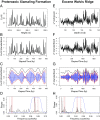Proterozoic Milankovitch cycles and the history of the solar system
- PMID: 29866837
- PMCID: PMC6016783
- DOI: 10.1073/pnas.1717689115
Proterozoic Milankovitch cycles and the history of the solar system
Abstract
The geologic record of Milankovitch climate cycles provides a rich conceptual and temporal framework for evaluating Earth system evolution, bestowing a sharp lens through which to view our planet's history. However, the utility of these cycles for constraining the early Earth system is hindered by seemingly insurmountable uncertainties in our knowledge of solar system behavior (including Earth-Moon history), and poor temporal control for validation of cycle periods (e.g., from radioisotopic dates). Here we address these problems using a Bayesian inversion approach to quantitatively link astronomical theory with geologic observation, allowing a reconstruction of Proterozoic astronomical cycles, fundamental frequencies of the solar system, the precession constant, and the underlying geologic timescale, directly from stratigraphic data. Application of the approach to 1.4-billion-year-old rhythmites indicates a precession constant of 85.79 ± 2.72 arcsec/year (2σ), an Earth-Moon distance of 340,900 ± 2,600 km (2σ), and length of day of 18.68 ± 0.25 hours (2σ), with dominant climatic precession cycles of ∼14 ky and eccentricity cycles of ∼131 ky. The results confirm reduced tidal dissipation in the Proterozoic. A complementary analysis of Eocene rhythmites (∼55 Ma) illustrates how the approach offers a means to map out ancient solar system behavior and Earth-Moon history using the geologic archive. The method also provides robust quantitative uncertainties on the eccentricity and climatic precession periods, and derived astronomical timescales. As a consequence, the temporal resolution of ancient Earth system processes is enhanced, and our knowledge of early solar system dynamics is greatly improved.
Keywords: Bayesian inversion; Earth–Moon history; Milankovitch cycles; astrochronology; fundamental frequencies.
Conflict of interest statement
The authors declare no conflict of interest.
Figures



References
-
- Hinnov LA. Cyclostratigraphy and its revolutionizing applications in the Earth and planetary sciences. Geol Soc Am Bull. 2013;125:1703–1734.
-
- Laskar J, et al. A long-term numerical solution for the insolation quantities of the Earth. Astron Astrophys. 2004;428:261–285.
-
- Ma C, Meyers SR, Sageman BB. Theory of chaotic orbital variations confirmed by Cretaceous geological evidence. Nature. 2017;542:468–470. - PubMed
-
- Waltham D. Milankovitch period uncertainties and their impact on cyclostratigraphy. J Sediment Res. 2015;85:990–998.
-
- Laskar J, Fienga A, Gastineau M, Manche H. La2010: A new orbital solution for the long-term motion of the Earth. Astron Astrophys. 2011;532:1–15.
Publication types
LinkOut - more resources
Full Text Sources
Other Literature Sources
Molecular Biology Databases
Research Materials

